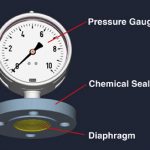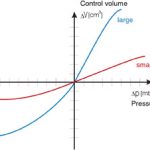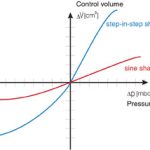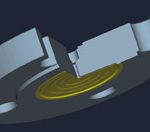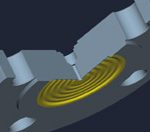A chemical seal system is generally used when the processes do not allow pressure gauges to be connected directly to the process medium. Examples include processes where very hot, highly corrosive or aseptic media is used, which must not come into contact with the measuring instrument.
Stefan Arendt
The chemical seal system comprises a pressure gauge with a chemical seal mounted onto it and a transmission fluid which transfers the process pressure hydraulically from the chemical seal to the measuring instrument. The chemical seal can be mounted either directly via a cooling element or when necessary by means of a capillary extension. The chemical seal itself comprises a body (for example, a flange) and a separating diaphragm connected to the body. Figure 1 shows the chemical seal in the form of a 3-D model mounted directly on a pressure gauge. There are three basic types of chemical seal: in-line chemical seals, capsule seals and the diaphragm seals shown in Figure 1, which have become the most important kind in practice.
How diaphragm seals function
The process pressure acts on the separating diaphragm and is then transferred by means of a filling liquid to the pressure gauge. This separating diaphragm is characterised by its spring rate, which is not specified for chemical seals as “force over displacement“, but rather by means of the displaced volume made available by the separating diaphragm (V per pressure change p). The spring rate of the separation diaphragm needs to be as small as possible, in order to minimise the influence of the diaphragm on the entire system. The separating diaphragm, in other words, makes as many displacement volumes available as possible with the smallest possible pressure changes. This characteristic quantity is known as the k-factor; its unit is cm3/bar. The diaphragm characteristic is generally shown with the aid of its curve. It can be seen from the gradient of this characteristic curve how “hard“ or “soft“ the diaphragm is considered to be. The steeper (“softer“) the characteristic curve, the less influence the temperature has on the system or – to put it another way – the higher the k-factor, the less the temperature effect.
Consequences for practice
Combinations of a pressure gauge and a chemical seal system must of course be guaranteed to function perfectly under all operating conditions. Apart from its actual function, a chemical seal system has to fulfil two further criteria. On the one hand the system’s actuating time has to be acceptable for the application and on the other hand the zero drift due to fluctuations in temperature has to be minimised. In a chemical seal system which is hermetically sealed the volume of the filling or transmission fluid changes with the temperature. If the temperature increases in the process or the environment, the transmission fluid expands against the rigidity of the separating diaphragm. The pressure is built up internally in the system as a result of the resistance of the diaphragm can to all intents and purposes be considered as the zero displacement of the measuring instrument. The magnitude of the zero displacement depends on the characteristic curve of the separating diaphragm, i.e. on the k-factor. The higher the k-factor, the lesser the influence of temperature. The following criteria influence the k-factor in practice:
• the working diameter of the separating diaphragm, whereby a larger diameter has a lesser influence on temperature,
• the diaphragm thickness – the thinner the diaphragm, the lesser influence of temperature,
• the diaphragm material – the softer the material, the lesser the influence of temperature.
Figure 2 shows the characteristic curve of one of the above-mentioned factors. In reality there are only approximately straight lines (elastic range of the diaphragm) with asymp-totic approximations on horizontals in the boundary regions of the diaphragms (onset of plastic deformation).
Normally, critical applications can be designed by varying the working diameter and diaphragm thickness to obtain acceptable measuring arrangements, whereas the diaphragm material is generally determined by the process medium. A larger working diameter generally demands a larger process connection, for example a larger connection flange entailing higher costs. Reducing the thickness of the diaphragm can have a negative effect on process safety, i.e. with a corrosive medium or during cleaning, because the chemical seal diaphragm is undoubtedly the weakest mechanical link in the process chain. Thicker diaphragms are therefore preferable.
Development of step diaphragms
Up to now a wide variety of sinusoidally corrugated diaphragms have available on the market. The already patented step diaphragm (Fig. 3) was developed on the basis of extensive studies with differently de-signed diaphragms. Unlike the sinusoidally corrugated diaphragm (Fig. 4), the step diaphragm takes the form of a staircase which rises from the inside to the outside. The characteristic curve of this step diaphragm differs from the conventional sinusoidal version. The curve gradient becomes consider-ably steeper, that is to say the influence of temperature declines because the diaphragm is softer (Fig. 5).
The following example explains the practical consequences. The influence of temperature was determined with both a sinusoidal and a step diaphragm, by means of a pres-sure transmitter connected by a 4 m long capillary extension to a flange type chemical seal (DN 80, PN 40) made of chromium-nickel steel 1.4571. Silicone oil was used as the filling medium. The influence of temperature in the case of the chemical seal with a sinusoidal diaphragm became apparent at 0.35 mbar/10 °C, whereas as far as the chemical seal with a step diaphragm was concerned, this influence did not become evident until 0.03 mbar/10°C. The values for the capillary extension were 1.6 mbar/10 °C for the sinusoidal type and only 0.2 mbar/10 °C in the case of the step type.
Advantages for technical applications
Previously critical applications with regard to temperature sensors, for example, ones with long capillary extensions or asymmetrical structures for differential pressure measurements (different capillary extension lengths, different chemical seals) will in future only exhibit minimal differences as far as the temperature is concerned (zero drift). A crucial improvement has been achieved in respect of pressure measurement reproducibility at fluctuating temperatures, for example between day and night or between summer and winter.
If the application requires a thicker diaphragm, for example if there is a risk of corrosion, the diaphragm thickness can be increased due to the staircase shape of the diaphragm, with no detrimental effects on the technical measuring properties, which can even be improved as compared with sinusoidally corrugated diaphragms. Furthermore, cleaning the diaphragm surface is considerably easier than with corrugated diaphragms thanks to the geometry, especially if the corrugations are short and high.
It goes without saying that – like the other diaphragms from the same manufacturer – this chemical seal has a diaphragm bed, which not only prevents plastic deformation of the diaphragm but also ensures that the volume is optimised (i.e. minimised).
WIKA Alexander Wiegand
Fax: ++49/9372/13 24 06
Further information cpp-204
Unsere Webinar-Empfehlung
Die Websession „Wasserstoff in der Chemie – Anlagen, Komponenten, Dienstleistungen“ (hier als Webcast abrufbar) zeigt technische Lösungen auf, die die Herstellung und Handhabung von Wasserstoff in der chemischen Industrie sicher machen und wirtschaftlich gestalten.
Ob effizienter…
Teilen:



